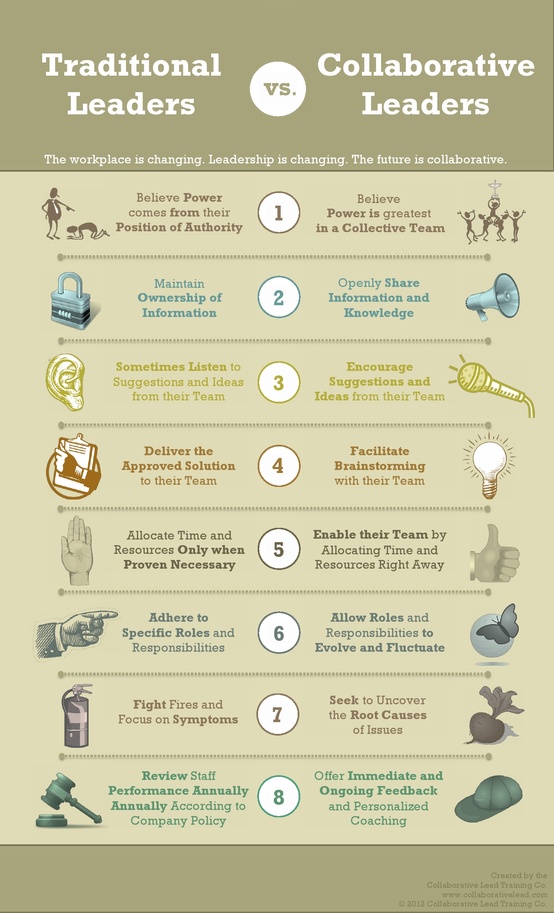Collaborative Leadership and Problem Solving
 We saw this infographic from the Collaborative Lead Training Company comparing traditional leaders with collaborative leader and we thought it nicely summarized many of the best practices we see with clients who are implementing Critical Thinking Skills (CTS) to improve their operations.
We saw this infographic from the Collaborative Lead Training Company comparing traditional leaders with collaborative leader and we thought it nicely summarized many of the best practices we see with clients who are implementing Critical Thinking Skills (CTS) to improve their operations.
Believe Power is Greatest in a Collaborative Team – Collaborative leadership is more than a set of lists and processes. It is a mindset that great ideas can come from anyone on the team, not just the leader. Companies that effectively avoid and fix problems understand this and tap everyone in the organization to contribute.
Openly Share Information and Knowledge – As we have stated in numerous blog posts, information is the lifeblood of effective problem solving. Leaders who share what they know and ask effective questions to learn what their team members know are going to outperform traditional, close-to-the vest leaders. And by harnessing the power of knowledge management systems, they can easily share their knowledge beyond their team and plant.
Encourage Suggestions and Ideas from Their Teams – At its very core effective problem solving relies on the knowledge and experience of everyone on the team. This institutional memory is wasted if the collaborative leader thinks he/she has all the answers or doesn’t know what questions to ask to narrow down the root cause of a problem.
Facilitate Brainstorming with Their Team – Brainstorming is great because it can help develop a list of possible causes. But effective questioning helps collaborative leaders winnow down the possible causes by converting data about the problem into useable information.
Enable Their Team by Allocating Time and Resources Right Away – We wrestle with this one a little bit because we’re not sure what is meant by “right away”. Truly effective leaders ask questions to set priority on which issues should receive time and resources (by the way, time is a resource). Ideally, the collaborative leader makes this process visible and works with the team to set this priority so everyone agrees the most important issues are being tackled first and there is greater commitment to the course of action.
Allow Roles and Responsibilities To Evolve and Fluctuate – We have seen this time and time again. Collaborative leaders can be students, as well as teachers, and they can learn a great deal from their teams. By having flexibility about roles and responsibilities, collaborative leaders can focus team members’ skills to the most pressing issues and not get hung up on rank-and-order issues. Our most effective problem solving clients use Process Coaches, line operators who have been trained to facilitate CTS use with their peers, supervisors and plant leadership.
Seek to Uncover the Root Causes of Issues – This does not mean the leader has to be Sherlock Holmes. But it does mean the leader must be committed to getting to root cause, not just applying band aides to get things running again. Team members want to know issues are corrected, not just patched, which can lead to recurrence or worse issues because of the quick fix.
Offer Immediate and Ongoing Feedback and Personalized Coaching – Too often traditional leaders wait until the formal performance review to provide feedback. Collaborative leaders are more likely to provide meaningful and personalized feedback because they are on the scene and understand the projects being worked on.
In reading the traditional vs. collaborative leaders list, we can’t help but think how slim the odds are that a CTS initiative would succeed in a traditional leadership organization. We’re not saying it’s impossible, but CTS initiatives that achieve meaningful results in preventing and correcting problems are much more likely in collaborative leadership organizations than in traditional leadership organizations where all the power and control are held by a few managers.
